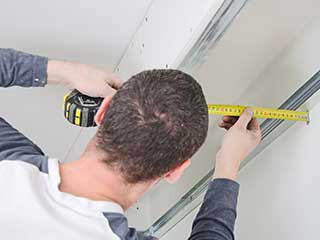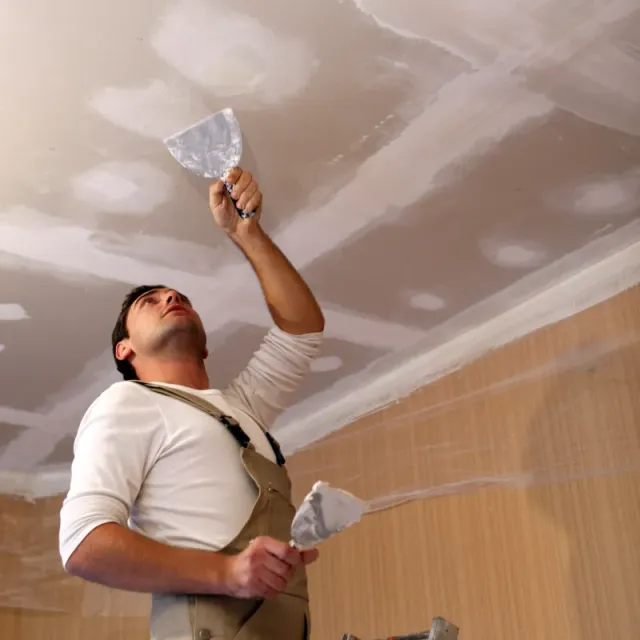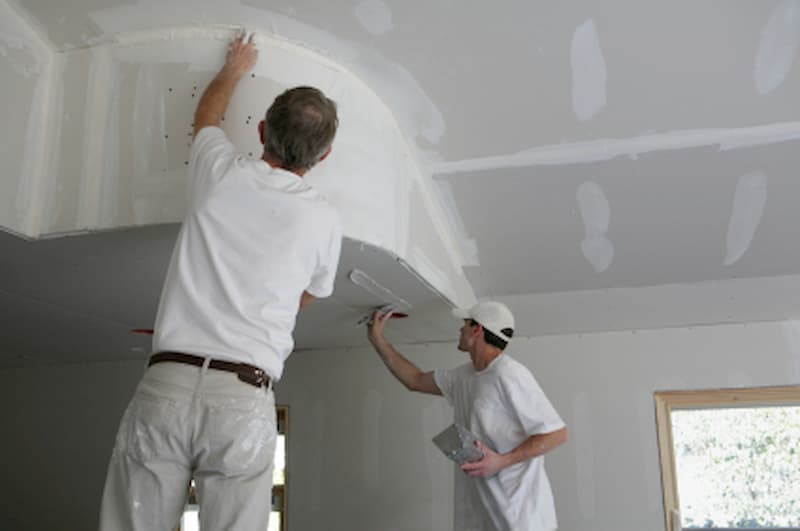Step-by-Step Approaches to Achieving Flawless Drywall Repair Work and Installation
Achieving perfect drywall repair and installation needs a systematic approach. It includes recognizing the different kinds of drywall and the devices needed for the task. Correct location prep work is vital before starting any kind of job. drywall contractor. Each action, from covering openings to mounting new sheets, needs focus to information. The process does not end with installation; completing strategies are important for a polished look. The next steps will assure a smooth outcome, however what exactly do they require?
Recognizing Drywall Kind and Equipment Needed

The installment tools are just as essential. An utility knife is crucial for reducing drywall sheets, while a drywall saw can help in making precise cuts for electrical outlets or components. T-squares assure precise dimensions, and drywall screws or nails protect the panels to wall surface studs. Furthermore, a drywall lift can help with the setup of huge sheets, decreasing physical stress. Experience with these devices and types significantly adds to the performance and top quality of drywall jobs.
Preparing the Area for Fixing or Setup
Preparing the area for drywall fixing or installation is essential to ensure a effective and smooth process. First, the surrounding room ought to be removed of furniture and various other obstacles to provide adequate functioning room. This not just ensures security but also protects against damage to belongings. Next, it is necessary to cover the floor with ground cloth to catch any kind of particles or dust created throughout the job.
Furthermore, the walls should be inspected for any type of loose paint or wallpaper that may disrupt adhesion. Eliminating these aspects produces a tidy surface for the brand-new drywall. Before start, it is advisable to turn off power to electrical outlets or components in the vicinity. Making certain appropriate lights in the work area will additionally enhance presence and focus throughout the repair work or installation process. Drywall Installation Ogden Utah. By meticulously preparing the location, one prepares for a successful drywall task
Step-by-Step Refine for Patching Holes

Covering holes in drywall needs a methodical strategy to assure a seamless fixing. The initial step includes reviewing the size of the opening. For little holes, a patching substance may be adequate, while bigger openings demand a patch. Next off, the broken area needs to be cleansed and prepared by getting rid of any type of loose debris.
For little holes, applying read more spackling substance with a putty knife is advised, smoothing it over the opening and feathering the edges. When dry, sanding the area guarantees a smooth surface. For larger holes, a drywall patch ought to be reduced to dimension, placed over the hole, and protected with screws. After mounting the patch, the same spackling process is duplicated, complied with by fining sand.
The patched area has to be topped and painted to match the bordering wall. This thorough procedure ensures a professional look and expands the lifespan of the fixing.
Mounting New Drywall Sheets: A Comprehensive Guide
Installing new drywall sheets needs careful preparation and execution to ensure a tough and visually attractive coating. The location has to be gauged properly to identify the number of sheets required. It is important to select the right thickness, commonly 1/2-inch for indoor walls and 5/8-inch for ceilings or fire-rated applications.
Next, the studs or framework need to be examined for any abnormalities, seeing to it they are lined up and effectively spaced. When putting the drywall sheets, they should be placed horizontally to decrease seams and improve structural integrity. A drywall lift can be valuable for overhanging installations.
Fastening the sheets with drywall screws at appropriate periods makes sure a safe setup. It's crucial to countersink the screws slightly below the surface to plan for the ending up procedure. Complying with these standards will lead to a strong structure, prepared for the following steps in drywall ending up.
Completing Touches: Taping, Mudding, and Sanding Methods
Once the drywall sheets are securely secured, the focus moves to the finishing touches that will offer a refined appearance. This procedure starts with taping, making use of either paper or fiberglass mesh tape to cover the seams between sheets. The tape ensures a smooth change, reducing the danger of fracturing. Following taping, mudding is essential; a joint compound is used over the tape to fill up spaces and produce a smooth surface. Usually, numerous coats are necessary, each one feathered out additionally than the previous to minimize exposure.
After sufficient drying time, sanding is the final action in attaining a flawless finish. A fine-grit sandpaper is utilized to smooth the dried compound, guaranteeing there are no blemishes or bumps. Interest to detail throughout this phase is considerable, as it considerably impacts the general look of the wall. The end outcome ought to be an even, professional-looking surface ready for priming and paint.
Regularly Asked Questions
How Do I Choose the Right Drywall Thickness for My Job?
To choose the appropriate drywall thickness, think about the job's purpose, area, and structural requirements. Requirement thicknesses include 1/2-inch for general use and 5/8-inch for fire-rated applications, guaranteeing longevity and compliance with building ordinance.

Can I Mount Drywall Over Existing Drywall?
Yes, setting up drywall over existing drywall is possible. It is vital to ensure the underlying surface is safe and free from damages. Proper attachment and factor to consider of density are crucial for a successful installment.
What Are the Finest Practices for Drywall Disposal?
The best techniques for drywall disposal include reusing when feasible, making use of local waste management solutions, and adhering to standards for hazardous materials if appropriate. Drywall Repair Ogden UT. Effectively sealing and identifying waste warranties compliance and safety and security during disposal
The length of time Should I Wait On Mud to Dry Prior To Sanding?
Commonly, one should wait 24-hour for drywall mud to completely dry prior to sanding. Nevertheless, drying out time can differ based upon humidity and temperature, so looking for a company appearance is suggested before continuing.
Exist Eco-Friendly Drywall Options Available?
Yes, eco-friendly drywall choices are available. These alternatives frequently utilize recycled materials, low-VOC adhesives, and sustainable production methods, reducing ecological effect while giving effective insulation and longevity for different building and remodelling projects.
An energy blade is crucial for reducing drywall sheets, while a drywall saw can assist in making exact cuts for electrical outlets or components. Preparing the location for drywall repair service or setup is vital to ensure a smooth and efficient process. Patching holes in drywall calls for a methodical method to guarantee a seamless repair. Installing new drywall sheets requires mindful preparation and execution to assure a aesthetically enticing and durable surface. Yes, setting up drywall over existing drywall is possible.